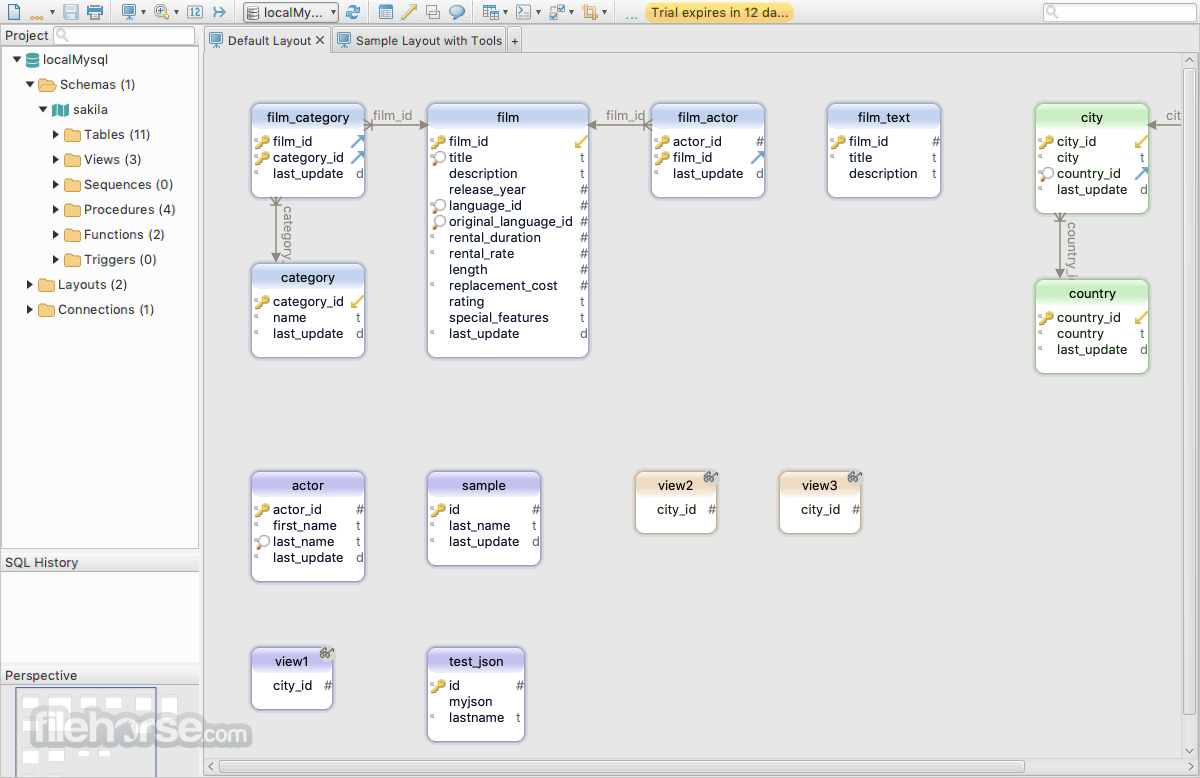-
Latest Version
-
Operating System
Windows 7 64 / Windows 8 64 / Windows 10 64 / Windows 11
-
User Rating
Click to vote -
Author / Product
-
Filename
DbSchema_9_0_0.exe
Sometimes latest versions of the software can cause issues when installed on older devices or devices running an older version of the operating system. Software makers usually fix these issues but it can take them some time. What you can do in the meantime is to download and install an older version of DbSchema 9.0.0.
For those interested in downloading the most recent release of DbSchema or reading our review, simply click here.
All old versions distributed on our website are completely virus-free and available for download at no cost.
We would love to hear from you
If you have any questions or ideas that you want to share with us - head over to our Contact page and let us know. We value your feedback!
What's new in this version:
Logical Design:
DbSchema supports logical design. The logical design is database-independent, with entities and sub-entities:
Logical Design Sub-Entities:
- Sub-entities can be created by adding a field of type sub-entity to a table
There are also supported different relation types:
Logical Design Relations:
- The logical model can be converted to a physical model and synchronized with the database
- We continue to improve the logical design also in the upcoming releases
Reverse engineer using DDL:
- In the previous versions, we reverse-engineer the schema by reading the metadata from system tables
- For most of the databases, we call methods from the JDBC driver, and only for a few of them did we execute direct queries on the system tables
- Now, we are using a DDL parser that can reverse engineer the schema from the CREATE TABLE DDL statement
- The DDL is generated using commands like ‘Show create table’, or using a dedicated procedure (SqlServer)
Comment Tags:
- Besides text, the table, column, and foreign keys can use key/value comment tags
- The tags can be used in the automation scripts, and in the logical design for the entity or field’s physical name
Reverse Engineer Using DDL:
- This allows us to reverse engineer all parameters, like collation, partition keys, etc., and more table-specific parameters - like temporal tables, etc
- This feature is available for all databases where we found a way to generate the table DDL
Here are the current databases where this feature is implemented:
- MySql, MariaDb, Oracle, SqlServer, AzureSQL, Snowflake, Redshift, Vertica, Sqlite, Exasol, SAPHana, GoogleBigQuery, Databricks, Cassandra
- Improvements for MongoDB
- We do diagrams and schema validation rules for MongoDB. Whenever a validation rule is defined, we reverse engineer the collection structure using it
- If not, we deduce the collection structure by introspecting a few documents
- Whenever you design a collection, the collection validation rule gets updated
Automation Scripts for generating HTML or PDF Documentation:
- We added more parameters for generating the HTML or PDF documentation
- Therefore we created a more flexible method in Java. Please have a look on the DbSchema API for details
Further improvements:
- Feature: Result Pane error message as dialog
- Feature: InfluxDB integrations
- Feature: PDF documentation, add parameter for skipping tooltip comments. Improve look.
- Feature: Add more options to the documentation dialog
- Feature: Exasol support hashtype data type
- Feature: Color picker editable hex value
- Bug: Fixes and improvements in the DDL Parser
- Bug: MongoDB load statement using the driver class loader. This solves issues with ObjectId.
 OperaOpera 109.0 Build 5097.59 (64-bit)
OperaOpera 109.0 Build 5097.59 (64-bit) iTop VPNiTop VPN 5.4.0 - Fast, Safe & Secure
iTop VPNiTop VPN 5.4.0 - Fast, Safe & Secure PhotoshopAdobe Photoshop CC 2024 25.7 (64-bit)
PhotoshopAdobe Photoshop CC 2024 25.7 (64-bit) iAnyGoTenorshare iAnyGo 4.0.15
iAnyGoTenorshare iAnyGo 4.0.15 Opera GXOpera GX 109.0.5097.62 (64-bit)
Opera GXOpera GX 109.0.5097.62 (64-bit) Adobe AcrobatAdobe Acrobat Pro 2024.002.20687
Adobe AcrobatAdobe Acrobat Pro 2024.002.20687 BlueStacksBlueStacks - Play on PC 5.21.150
BlueStacksBlueStacks - Play on PC 5.21.150 Hero WarsHero Wars - Online Action Game
Hero WarsHero Wars - Online Action Game Data Recovery4DDiG Windows Data Recovery 9.8.6
Data Recovery4DDiG Windows Data Recovery 9.8.6 TradingViewTradingView - Trusted by 60 Million Traders
TradingViewTradingView - Trusted by 60 Million Traders









Comments and User Reviews